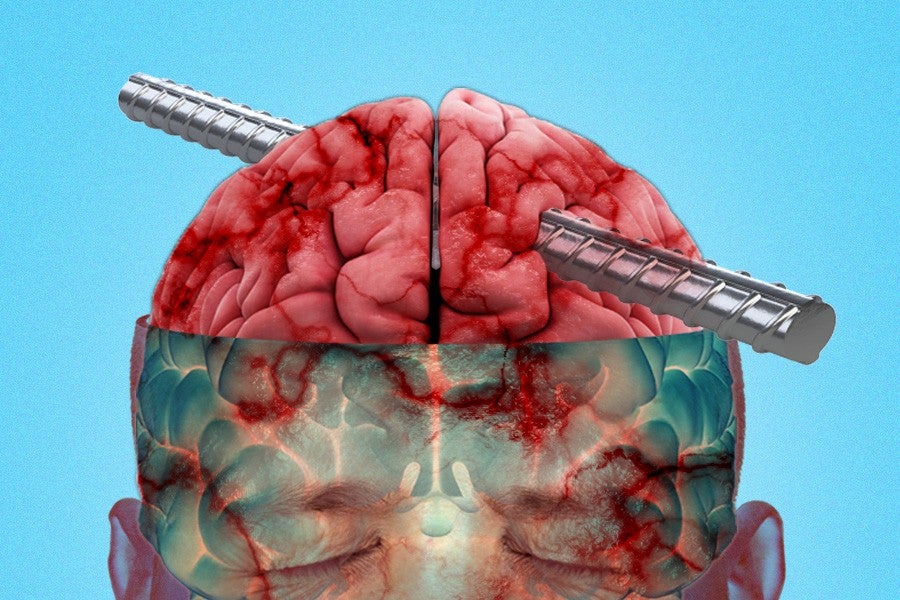The human brain is just about the most complex structure in the known universe. It can change the way other brains think; it can productively let you live out your violent fantasies in the safety of your own head; and it’s really good at curating a 2,000-track playlist of painful memories and unresolved issues right as you’re about to fall asleep.
Amazingly, it’s also capable of recovering even after losing a big-ass chunk of itself.
This latter phenomenon was recently demonstrated by a new case study chronicling the case of a six-year-old boy who had a third of his brain removed in an attempt to control his epileptic seizures. Doctors removed the right occipital and posterior temporal lobes, which are considered vital for processing visual information and words. And yet, the remaining parts of his brain compensated for visual tasks that the now-missing parts would have normally done (such as recognizing faces and objects). The boy’s reading proficiency also remained above average after the surgery, meaning the brain was largely unaffected, even after being reduced by a third.
This certainly isn’t the first time that someone has lived (and even thrived) after damaging their brain, either. Here are some of the wildest examples through history…
The Man Who Lives Normally with Damage to 90 Percent of His Brain
First described in the The Lancet in 2007, the case of a French man who lives a relatively ordinary life — despite only having a tenth of his brain unscathed — has been puzzling scientists for more than a decade. The man reportedly visited his doctor complaining of mild weakness in his left leg, only to have brain scans reveal that his skull was mostly filled with fluid, leaving only a thin outer layer of actual brain tissue.
The man was later diagnosed with a chronic case of non-communicating hydrocephalus, which causes fluid to slowly build up in the brain. Despite this, the man was still working as a civil servant, married with two children and considered to be surprisingly healthy overall.
The Woman Who Lived 24 Years Without Knowing Her Cerebellum Was Missing
Back in 2014, Chinese doctors discovered that a 24-year-old woman was living without her cerebellum, an essential section of the brain that plays an important role in motor control and holds up to 50 percent of a person’s total neurons (nerve cells). And yet, the woman had no idea of her condition and was living a pretty normal life. “She is married with a daughter, and her pregnancy and delivery were described as uneventful,” doctors wrote in a case study. “Her parents had no history of neurological disorders.”
She was eventually diagnosed with “complete primary cerebellar agenesis,” a condition reportedly so rare that the number of cases can be counted on two hands, most of which have ended in death or permanent brain damage. Doctors believe that this particular woman was able to live with only minor ailments — slightly slurred speech and an unsteady walk — because whatever caused her cerebellum to dissipate happened early in life, allowing her brain to adapt (similar to the six-year-old boy mentioned earlier).
The Man Who Survived a Large Iron Rod Being Driven Through His Head
Phineas Gage became one of the most famous neuroscience patients in history in 1848 after a tamping iron — 43 inches long, 1.25 inches in diameter and weighing 13.25 pounds — penetrated his left cheek, ripped into his brain and exited through his skull. While he was blinded in his left eye, the story claims that he remained consciousness enough to tell a doctor that same day, “Here is business enough for you.”
While Gage survived the event, observations made by John Martyn Harlow, the doctor who treated him for a few months after the incident, suggest that he experienced a major personality change as a result of his missing brain parts. His friends found him “no longer Gage,” Harlow wrote. He couldn’t stick to plans, uttered “the grossest profanity” and showed “little deference for his fellows.” However, another report of Gage’s physical and mental condition shortly before his death suggests that these serious mental changes were only temporary, and that he was much more functional and socially adapted later in life.
The Man Who Became a Prolific Artist After Losing Part of His Brain
In August 1989, 35-year-old chiropractor Jon Sarkin suffered a stroke that resulted in the surgical removal of various parts of his brain. After the surgery, Sarkin experienced an inexplicable (and constant) urge to draw, despite having no prior interest in art. Although he was still working as a chiropractor for two days every week, his enthusiasm toward the job was gone — he would doodle in between patients.
Years later, Sarkin became an artist whose work can sell for more than $10,000 per canvas. Sarkin’s particular condition — known by doctors as “sudden artistic output” — is one of only three cases caused by brain injury to have ever been documented.
The Man Who Became a Mathematical Genius After a Concussion
In 2002, Jason Padgett was attacked by two men outside of a karaoke bar, leaving him with a severe concussion and post-traumatic stress disorder. But the injury also affected his brain in ways that make everything in his world appear to have mathematical structure, essentially transforming him into a mathematical genius and giving him the ability to visualize geometric shapes and angles. “I see shapes and angles everywhere in real life,” Padgett told LiveScience. “It’s just really beautiful.”
Before the attack, Padgett was a furniture salesman (as well as a self-described jock and partier) with little interest in academics. But the assault resulted in him becoming one of a rare set of individuals with acquired savant syndrome, in which a normal person develops prodigious abilities after a severe injury. Even fewer of these individuals have acquired mathematical abilities like Padgett.

